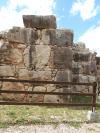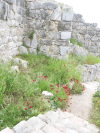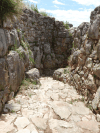
Remnants of the immense walls of the acropolis of Tiryns. (1.6M)
From the Tiryns entry in Wikipedia:
Tiryns is a Mycenaean archaeological site in Argolis in the Peloponnese, and the location from which the mythical hero Heracles performed his Twelve Labors. It lies 20 km (12 miles) south of Mycenae.
Tiryns was a hill fort with occupation ranging back seven thousand years, from before the beginning of the Bronze Age. It reached its height of importance between 1400 and 1200 BCE, when it became one of the most important centers of the Mycenaean world, and in particular in Argolis. Its most notable features were its palace, its Cyclopean tunnels and especially its walls, which gave the city its Homeric epithet of "mighty walled Tiryns". Tiryns became associated with the myths surrounding Heracles, as the city was the residence of the hero during his labors, and some sources cite it as his birthplace.
The famous megaron of the palace of Tiryns has a large reception hall, the main room of which had a throne placed against the right wall and a central hearth bordered by four Minoan-style wooden columns that served as supports for the roof. Two of the three walls of the megaron were incorporated into an archaic temple of Hera. The site went into decline at the end of the Mycenaean period, and was completely deserted by the time Pausanias visited in the 2nd century CE.
In 1300 BCE the citadel and lower town had a population of 10,000 people covering 20-25 hectares (50-62 acres). Despite the destruction of the palace in 1200 BCE, the city population continued to increase and by 1150 BCE it had a population of 15,000 people.
Tiryns is first referenced by Homer, who praised its massive walls. Ancient tradition held that the walls were built by the Cyclopes because only giants of superhuman strength could have lifted the enormous stones. After viewing the walls of the ruined citadel in the 2nd century CE, the geographer Pausanias wrote that two mules pulling together could not move even the smaller stones.
Tradition also associates the walls with Proetus, the sibling of Acrisius, king of Argos. According to the legend Proetus, pursued by his brother, fled to Lycia. With the help of the Lycians, he managed to return to Argolis. There, Proetus occupied Tiryns and fortified it with the assistance of the cyclopes. Thus Greek legend links the three Argolic centers with three mythical heroes: Acrisius, founder of the Doric colony of Argos; his brother Proetus, founder of Tiryns; and his grandson Perseus, the founder of Mycenae. But this tradition was born at the beginning of the historical period, when Argos was fighting to become the hegemonic power in the area and needed a glorious past to compete with the other two cities.
The area has been inhabited since prehistoric times. A lesser neolithic settlement was followed, in the middle of the 3rd millennium BCE, by a flourishing early pre-Hellenic settlement located about 15 km (9 miles) southeast of Mycenae, on a hill 300 m (980 ft) long, 45-100 m (148-330 ft) wide, and no more than 18 m (59 ft) high. From this period survived under the yard of a Mycenaean palace, an imposing circular structure 28 m (92 ft) in diameter, which appears to be a fortified place of refuge for the city's inhabitants in time of war, and/or a residence of a king. Its base was powerful, and was constructed from two concentric stone walls, among which there were others cross-cutting, so that the thickness reached 45 m (148 ft).
The superstructure was clay and the roof was made from fire-baked tiles. The first Greek inhabitants—the creators of the Middle Helladic civilization and the Mycenaean civilization after that—settled Tiryns at the beginning of the Middle Helladic period (2000–1600 BCE), though the city underwent its greatest growth during the Mycenaean period. The Acropolis was constructed in three phases, the first at the end of the Late Helladic II period (1500–1400 BCE), the second in Late Helladic III (1400–1300 BCE), and the third at the end of the Late Helladic III B (1300–1200 BCE). The surviving ruins of the Mycenaean citadel date to the end of the third period. The city proper surrounded the acropolis on the plain below.
The disaster that struck the Mycenaean centers at the end of the Bronze Age affected Tiryns, but it is certain that the area of the palace was inhabited continuously into the early Archaic period, until the middle of the 8th century BCE (a little later a temple was built in the ruins of the palace).
At the beginning of the Classical period Tiryns, like Mycenae, became a relatively insignificant city. When Cleomenes I of Sparta defeated the Argives, their slaves occupied Tiryns for many years, according to Herodotus. Herodotus also mentions that Tiryns took part in the Battle of Plataea in 480 BCE with 400 hoplites. Even in decline, Mycenae and Tiryns were disturbing to the Argives, who in their political propaganda wanted to monopolize the glory of legendary (and mythical) ancestors. In 468 BCE Argos completely destroyed both Mycenae and Tiryns, and—according to Pausanias—transferred the residents to Argos, to increase the population of the city. However, Strabo says that many Tirynthians moved to found the city of Halieis, modern Porto Heli.
Despite its importance, little value was given to Tiryns and its mythical rulers and traditions by epics and drama. Pausanias dedicated a short piece (2.25.8) to Tiryns, and newer travelers, traveling to Greece in search of places where the heroes of the ancient texts lived, did not understand the significance of the city.
The Archaeological Sites of Mycenae and Tiryns are a UNESCO World Heritage Site.
All pictures are © Dr. Günther Eichhorn, unless otherwise noted.
















This page contains 16 pictures
Here are the links to the other main pages on Greece:
Page last updated on Fri Dec 2 12:10:50 2022 (Mountain Standard Time)
Tiryns on soaring.geichhorn.com